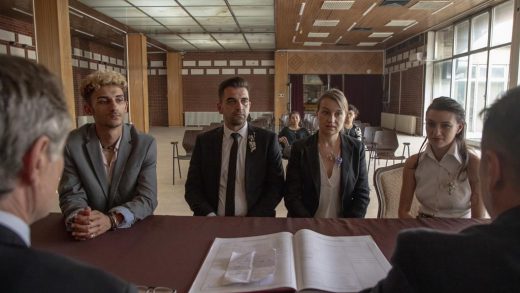
Local body elections are held every three years by postal vote, but fewer than half of eligible voters even take part.
With engagement continuing to fall amid concerns the makeup of local government does not reflect the broader community, one first term Timaru councillor is urging more people to take a run at local government ahead of this year’s elections.
The average nationwide participation in the 2019 elections was 41.7 per cent, a figure that has progressively dropped in the three decades since local government reform, when voter participation sat at 57 per cent in 1989.
READ MORE:
* How to confront local govt election-year apathy?
* Cr Barbara Gilchrist becomes Timaru’s ‘biodiversity champion’
* The white, male, middle-aged face of local government
* A climate of change: Calls for diversity at the council table in 2019
Timaru district councillor Barbara Gilchrist, who ran a waste-free campaign for her debut run in 2019, said she is very keen to encourage more people to run for council, and would love to see “ordinary people” throwing their hats in the ring.
“There must be ways we can actually make that look like an interesting, viable thing for people to do.”
Gilchrist said it was her own “if only’s” which had prompted her run.
“’If only this pathway was accessible to everyone’, was one of my big ones.
“My husband is in a wheelchair, and often when we wanted to go for a walk we couldn’t because there were barriers, which seemed crazy.
“I guess I wanted to make sure little people’s voices were heard, people who aren’t well known or wealthy or a big player, just an ordinary person.”
BEJON HASWELL/ STUFF/Stuff
Timaru district councillor Barbara Gilchrist during her successful – and waste free – 2019 campaign for office.
Gilchrist said she initially intended to run for the District Health Board, until people suggested she take a swing at council.
She found an information session held by the Timaru District Council useful before she made her decision to run.
“Before you threw your name in the ring, the council held an information session, which was really good.
“They actually explained the process, and had information there for you – it was really useful, and you could ask questions.
“Even just getting you inside the council building helped to make you feel a little less uncomfortable about that.”
JOHN BISSET/Stuff
Barbara Gilchrist went topless alongside comedian Josh Thomson, speed skater Nicole Begg and mayor Nigel Bowen for a campaign to improve Timaru’s recycling rates. (File photo)
She said given her commitment to the environment, she decided to run a waste-free campaign.
“I had no posters, no flyers – we just made bookmarks with my information on them, and T-shirts.”
She acknowledged many people are effectively barred from participating in local government because it’s difficult to live off the pay, but also hard to combine with most jobs.
The minimum annual allowance a Timaru District councillor receives is $36,076, in Mackenzie, $18,956, and in Waimate it’s $19,309.
“One of the things that comes up is it’s not enough money to live on, but you’d need really quite a forgiving employer if you were trying to do it part-time – but those are technicalities, I don’t see it as anything that – with the will – we couldn’t actually figure out.”
“I mean, it’s just like people who are in the volunteer fire brigade – their employers go, that’s cool, if you need to leave a little earlier that’s OK, so perhaps something similar to that.”
Bejon Haswell/Stuff
Councillor Barbara Gilchrist hopes more people will throw their hats in the ring ahead of local body elections this year. (File photo)
Gilchrist works three days a week at another job, and leaves two days as “council days”, which she said may end up falling throughout the week, “but that’s the brain space I give it – two of my five working days”.
She said the workload can vary greatly, in terms of time commitment, and in how involved the work is.
“Like next week, I think I have a council commitment every day except Friday, but other weeks you might have nothing.”
“It’s one of those things where you can go as deeply as you want – if there’s stuff you’re interested in you can put your hand up.
“I’m involved in the CBD stuff which I love, and youth initiatives, and sustainability issues, so you’ve got the chance to get involved in the stuff that interests you.”
John Bisset/Stuff
The December 2019 Rangitata flooding occurred shortly after Gilchrist was elected to office, while Covid has marked the rest of her term. (File photo)
Gilchrist said while she has not been subjected to the same levels of trolling other female politicians regularly report, she has had some “pretty nasty emails” about the vaccine mandate.
“I mean, I made it quite clear I was a nurse when I was campaigning, would you really expect a nurse to not go with the strongest level of public health protection?”
Most of Gilchrist’s term has taken place during the pandemic, prefaced by the 2019 Rangitata floods just weeks after she was voted into office.
“I started in October 2019, we had the floods in December, and Covid in March.”
She acknowledged many see local government as irrelevant, dull or ineffectual.
“Councils seem to have a really bad reputation.
“I don’t even think it would matter what we did, people would think that.”
But she thought getting more people involved and making changes could help shift that perception.
“I think if people felt like, if they got onto council, they could make a difference, that would really help.
“I feel a bit like that about – I mean it was only a little thing, but it was big to me – getting some of those barriers removed from the walkways.
“That actually makes a difference to people and that wouldn’t have happened.
Bejon Haswell/Stuff
Gilchrist has a keen interest in environmental issues, running a waste-free campaign to get into council. (File photo)
“You also get to have a say on bigger things – you’re only one of ten, but you still have a certain amount of influence with the other eight elected members and the mayor.
“The wheels move slowly, but you can keep banging on about stuff.”
Local government association Local Government New Zealand represents the sector, which consists of 11 regional councils, 61 territorial authorities (11 city councils and 50 district councils) and six unitary councils (territorial authorities with regional council responsibilities such as Environment Canterbury), with the sole exception of Timaru District Council, which pulled out in September 2021 over LGNZ’s handling of the Three Waters reforms.
LGNZ chief executive Susan Freeman-Greene said local government plays a critical role in New Zealand’s democracy, “making sure people have meaningful influence over the decisions that affect their community and their daily lives.”
But Freeman-Greene acknowledged the “huge challenge” for local government “when it comes to diversity – it’s not representative of the makeup of Aotearoa New Zealand”.
“More than 80 per cent of elected members are Pākehā and the average age is 56 to 60 years old.
“Māori make up just 13.5 per cent of elected members and the percentage of Asian, Pasifika and other ethnicities has remained low and stagnant.
“Only 40.5 per cent are women, and only 21 out of 78 mayors and chairs are women. Young elected members (under 40) make up just 14 per cent despite making up the vast majority of our population.
“We need to shift this dynamic to help ensure a more truly representative local democracy,” Freeman-Greene said.
LGNZ’s survey of elected members from 2019 includes those elected to community and district health boards as well as territorial authorities such as district and regional councils, and points to some significant demographic shifts.
SUPPLIED
Local Government New Zealand chief executive Susan Freeman-Greene says local government is not representative of New Zealand. (File photo)
The survey found a much higher proportion of those elected in 2019 were first term members – 41 per cent compared to 27 per cent in 2016.
The numbers also point to a change in the ages of those elected, with increases in those under 40-years- old, as well as an increase in those 70-years-old and over.
The number of elected members under 40 had almost doubled (13.2 per cent) from the previous election (7.2 per cent), making it the largest group of under 40-year-olds since demographic records were kept, while the number of people over 70 rose from eight per cent in 2016 to more than 12 per cent in 2019.
Younger people are gaining some momentum in local government, with under 30-year-olds more than tripling their presence from 1.3 per cent in 2016 to more than four per cent in 2019.
The 2019 elections resulted in a higher proportion of women elected to local government than at any time, with 40.5 per cent women and 60 per cent men elected.
There is a strong correlation between being younger and being female, with significantly more men in the older age groups (60 years old and above).
JOHN BISSET/STUFF
Timaru District Council is the only local authority in the country to have pulled out of Local Government New Zealand. (File photo)
The proportion of Māori members reached 13.5 per cent in the 2019 elections, up from 10 per cent in 2016 – almost twice the proportion elected in 2013.
Māori members are more likely to be younger and female than non-Māori members.
New Zealand has a relatively high representation ratio, which refers to the number of residents represented by each elected member.
According to LGNZ, voting is higher when the ratio of residents to members is small.
New Zealand’s ratio of one 1 member per 5,000 people compares to New South Wales’ ratio of 1:3942, the United Kingdom’s 1:2600, Germany’s 1:250 and France’s 1:120.
LGNZ puts Timaru’s turnout for the 2019 local authority elections at 55.1 per cent of eligible voters, the Mackenzie District’s at 60.06 per cent, and Waimate’s at 52.1 per cent, while 45 per cent cast a vote in the regional council election for Environment Canterbury.
Nominations for local authority elections are open from July 15 until noon on August 12.
Candidates must be over 18 years old, a New Zealand citizen and be enrolled to vote in the area they plan to stand.
They can not nominate themselves, but must be nominated by two other people on an official nomination form sent to the council’s electorate officer.
Candidates must consent to their nomination going forward and pay a $200 deposit.
Voters can return their votes anytime after they receive voting documents, which are delivered from September 16 to 21, and voting closes this year at midday on October 8.
Preliminary results are announced that day, with final results returned between October 13 – 19.


